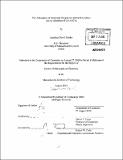| dc.contributor.advisor | Sylvia T. Ceyer. | en_US |
| dc.contributor.author | Fischer, Jonathan David | en_US |
| dc.contributor.other | Massachusetts Institute of Technology. Dept. of Chemistry. | en_US |
| dc.date.accessioned | 2011-04-04T16:18:08Z | |
| dc.date.available | 2011-04-04T16:18:08Z | |
| dc.date.copyright | 2010 | en_US |
| dc.date.issued | 2010 | en_US |
| dc.identifier.uri | http://hdl.handle.net/1721.1/62054 | |
| dc.description | Thesis (Ph. D.)--Massachusetts Institute of Technology, Dept. of Chemistry, 2010. | en_US |
| dc.description | Vita. Cataloged from PDF version of thesis. | en_US |
| dc.description | Includes bibliographical references. | en_US |
| dc.description.abstract | Molecular oxygen is observed to adsorb on 0.2 - 0.6 ML Au/Ni(111) surface alloys. Molecular oxygen adsorbates are characterized by their 0-0 stretching frequencies of 740 cm', 851 cm' and 962 cm', as measured by high resolution electron energy loss spectroscopy (HREELS). The concentrations and frequencies of these species are determined as a function of Au coverage. The concentrations and frequencies of dissociatively chemisorbed molecular oxygen below 0.3 ML Au are measured using HREELS. A Monte Carlo simulation was developed to determine possible binding sites for the molecular and atomic oxygen adsorbates, but no reasonable geometric model was able to match the experimental data. The trends in concentration and frequency of the molecular oxygen adsorbates are caused by the downward shift of the Ni d band as Au is alloyed into the surface and the corresponding reduction in charge transfer from the metal surface to the antibonding orbitals of 02. Adsorbed molecular oxygen dissociates between 110 and 150 K into unreactive atomic oxygen. At Au coverage above 0.5 ML, the surface is observed to undergo a reconstruction at 300 K, leading to a new molecularly adsorbed oxygen species with a vibrational frequency of 1050 cm1. The total amount of oxygen adsorbed on the surface is quantified using Auger electron spectroscopy. An accurate algorithm for determining the Au coverage of Au/Ni( 111) surface alloys using Auger electron spectroscopy is described. Carbon monoxide is catalyically oxidized on the Au/Ni(1 11) alloy surface at 85 K. Molecularly adsorbed 02 species with vibrational frequencies of 851 cm' and 962 cm- 1 are identified as the reactants. At 115 K, CO reacts with the remaining molecular oxygen species with a vibrational frequency of 741 cm-'. The molecularly adsorbed oxygen stabilized on the reconstructed surface is also capable of reaction with CO at 85 K. The ability of Au/Ni(1 11) alloys to catalyze repeated oxidation reactions is demonstated, suggesting that Au/Ni(1 11) alloys may be a practical and effective catalyst for oxidizing CO to CO 2 at cryogenic to room temperature. | en_US |
| dc.description.statementofresponsibility | by Jonathan David Fischer. | en_US |
| dc.format.extent | 239 p. | en_US |
| dc.language.iso | eng | en_US |
| dc.publisher | Massachusetts Institute of Technology | en_US |
| dc.rights | M.I.T. theses are protected by
copyright. They may be viewed from this source for any purpose, but
reproduction or distribution in any format is prohibited without written
permission. See provided URL for inquiries about permission. | en_US |
| dc.rights.uri | http://dspace.mit.edu/handle/1721.1/7582 | en_US |
| dc.subject | Chemistry. | en_US |
| dc.title | The adsorption of molecular oxygen on Au/Ni(111) alloys and its oxidation of CO at 85 K | en_US |
| dc.title.alternative | Molecular oxygen adsorbates on Au/Ni(111) alloy surfaces | en_US |
| dc.type | Thesis | en_US |
| dc.description.degree | Ph.D. | en_US |
| dc.contributor.department | Massachusetts Institute of Technology. Department of Chemistry | |
| dc.identifier.oclc | 707926171 | en_US |
